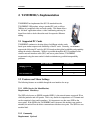
TANDBERG TANDBERG and Wireless LANs
the rollout of videoconferencing to be seamless and quick. Wireless LANs offer the
following productivity, convenience, and cost advantages over traditional wired networks:
• Mobility
: Wireless LAN systems can provide video users with the ability to make
video calls anywhere in their organization regardless if they have an Ethernet
connection in the room. This mobility supports productivity and service opportunities
not possible with wired networks.
• Installation Speed and Simplicity
: Installing a wireless LAN system can be fast
and easy and can eliminate the need to pull cable through walls and ceilings. This is
the concept behind ‘hot desking’.
• Installation Flexibility
: Wireless technology allows the network to go where wire
cannot go and allows the user to be more creative in deploying their video
conferencing needs.
•
Reduced Cost-of-Ownership
: While the initial investment required for wireless
LAN hardware can be higher than the cost of wired LAN hardware, overall
installation expenses and life-cycle costs can be significantly lower. Long-term cost
benefits are greatest in dynamic environments requiring frequent moves and changes.
• Scalability
: Wireless LAN systems can be configured in a variety of topologies to
meet the needs of specific applications and installations. Configurations are easily
changed and range from peer-to-peer networks suitable for a small number of users
to full infrastructure networks of thousands of users that enable roaming over a broad
area.
How Wireless LANs Are Used in the Real World
Wireless LANs frequently augment rather than replace wired LAN networks—often
providing the final few meters of connectivity between a wired network and the mobile user.
The following list describes some of the many applications made possible through the power
and flexibility of wireless LANs:
•
Doctors and nurses can use video in any room and not be limited to only using the
room with the system.
•
Network managers in dynamic environments minimize the overhead caused by
moves, extensions to networks, and other changes with wireless LANs.
• Training sites at corporations and students at universities use wireless connectivity to
minimize the cables to the desktop
•
Network managers installing networked computers in older buildings find that
wireless LANs are a cost-effective network infrastructure solution.
•
Trade show and branch office workers minimize setup requirements by installing pre-
configured wireless LANs needing no local MIS support.










